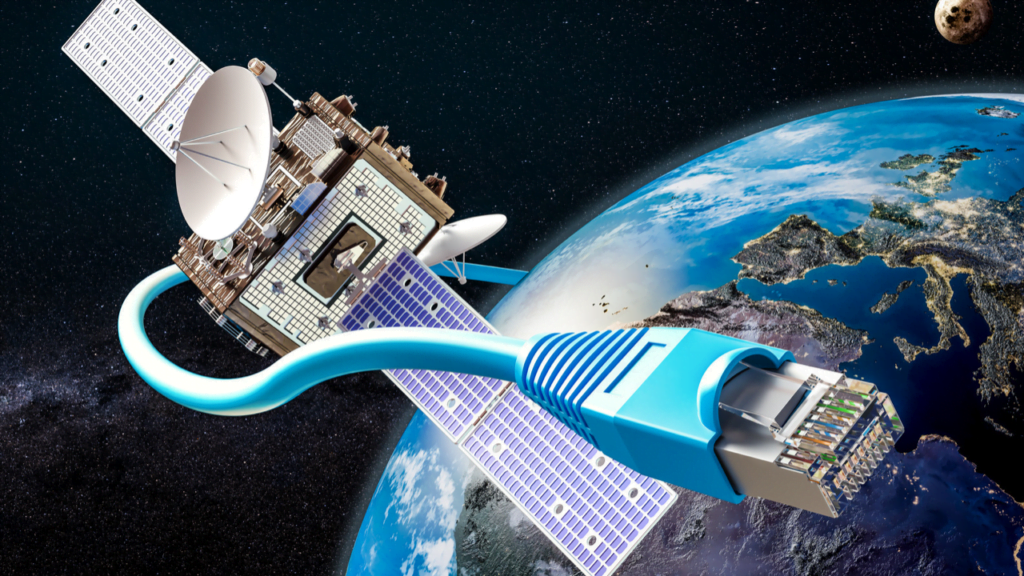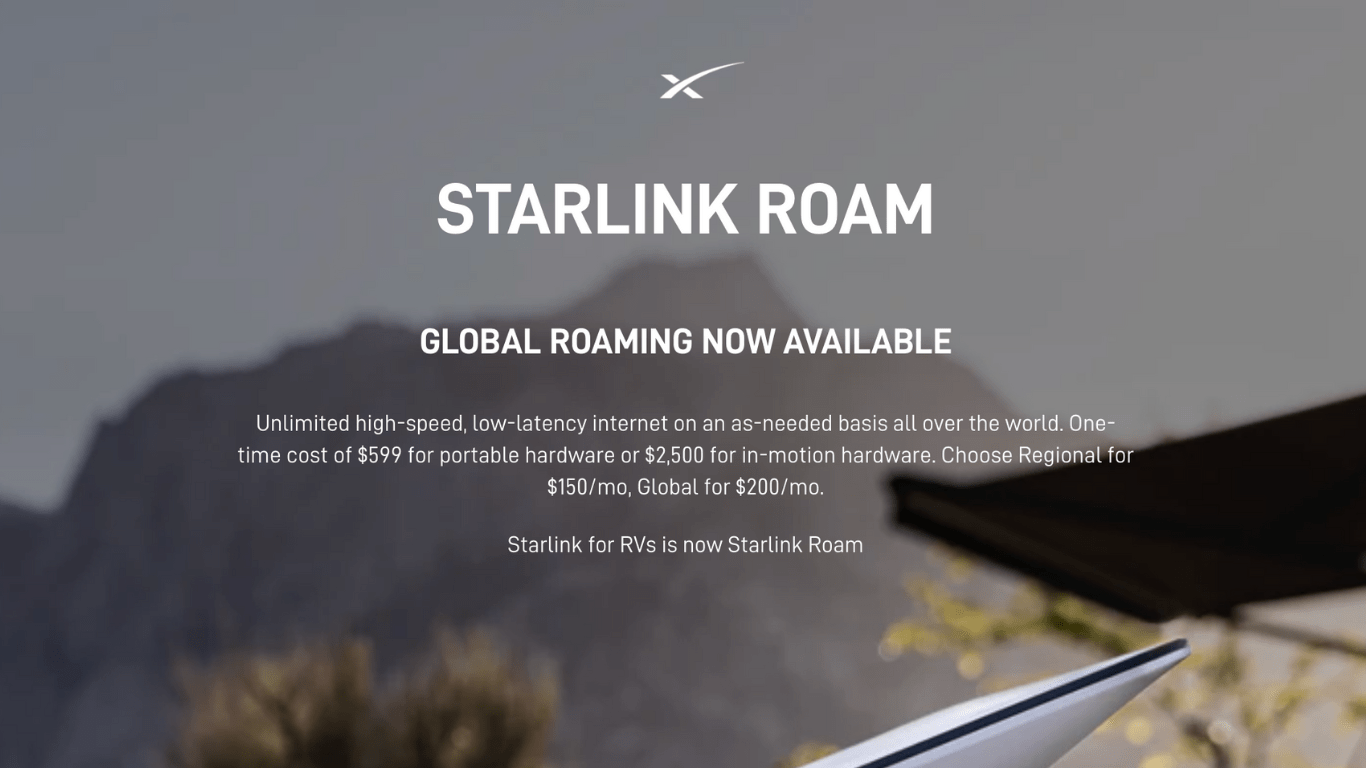Starlink has been on a roll.
Starlink, the internet satellite service provider, has recently announced That it’s rebranding its plans and prices alongside unveiling new capacity upgrades. This move is expected to offer more affordable broadband services to some, with most getting a price hike. Starlink new offering is Starlink Global Roaming on sea and land. The announcement of new plans and enhanced network capabilities is great news to many, as they can now get more value for their money if they travel worldwide.
Key Points:
- Starlink Global Maritime Service and Starlink Global Roaming Service are the first Starlink internet services to be offered globally.
- Starlink Global Maritime services are available and provide internet access for ships sailing in international waters and the waters off some countries EEZ.
- Starlink’s Global Roaming service is aimed at land-based users, but only a few customers can use it.
- SpaceX has started to deploy the first satellites that will make up the second-generation Starlink constellation.
- They are much larger than the first-generation satellites and will allow Starlink to cover more of the world.
- The V2 Mini satellites are much larger than the first-generation satellites and are claimed to have 4x the capacity.
- But these V2 mini satellites are tiny — a small fraction of the full-sized V2 satellites that SpaceX is planning to launch the full-sized V2 using its upcoming Starship and Super Heavy rockets.
- Future full-sized V2 satellites will be able to directly connect to cellular networks and allow for greater global coverage.
- Starlink has new filings with the FCC that show new models of Starlink consumer and business hardware.
- Starlink is testing service on Jets in the USA
- Starlink has been on a roll.
- Key Points:
- Growing the Constellation
- SpaceX designed the Starlink constellation around its massive reusable booster, called Starship.
- What will this mean for Starlink's current service tiers?
- Can I Transfer My Starlink Service?
- A mini terminal you can throw in your bag
- A New Starlink High-Performance Terminal.
- The Wrap

Growing the Constellation
Starlink’s constellation of satellites is now robust enough that it is able to offer customers global coverage plans.
SpaceX launched the first 21 satellites that will be used in the constellation of Starlink satellites.
The first 21 satellites were launched via the existing Falcon 9 rocket. This milestone marks a milestone for SpaceX as the new satellites can support 4x the data throughput of the first generation and enable Starlink to serve even more potential customers – particularly in congested areas.
The Starlink V2 satellites are actually much heavier and larger than those previously launched on the Falcon 9 launch vehicle – so SpaceX cannot launch more than 21 of the V2 Mini satellites at a time.
V2 satellite technology allowed for higher data rates by using more powerful phase array antennas and by using E-Band to backhaul data to ground stations. Customers will be able to use more bandwidth for their service uplinks when enough of the V2 minis are deployed.
It is likely that even more launch capacity will be needed for the second-generation satellites, as the V2 and V2 mini require much larger solar panels, and are much bigger satellites in general.

SpaceX is planning to bring T-Mobile coverage above & beyond initiative with the full version of the V2. Which aims to allow satellites to carry cellular antennas that act like cell towers to deliver basic messaging capabilities to cell phones.
SpaceX designed the Starlink constellation around its massive reusable booster, called Starship.
SpaceX initially planned to deploy its massive v2 satellite on their rocket ship called “Starship,” which would be capable of carrying a much larger payload than the current Falcon 9 launch vehicle. The smaller satellite V2 mini was developed to be a backup plan if Starship did not launch on schedule.
SpaceX is planning to use this V2 mini to deploy a massive constellation of satellites to support 2x the data throughput of the first generation. SpaceX is not completed with its Gen1 satellite constellation, but has received permission from the FCC to begin deploying the first 7,500 satellites that will make up a Gen2 Starlink constellation that will deliver a new generation of communications capabilities to the market.
SpaceX is planning to add about 4,500 satellites to its existing constellation to enable customers to use their existing networks more effectively. To that end, it was not until now that Starlink had enough satellites in orbit to be able to offer coverage around the world, including water and land – even if there are no ground stations at the sites where satellites are currently operating.
Starlink satellites that are now in their 1.5 generation have advanced satellite-to-satellite data links essential to providing coverage in areas with no ground stations. This is what enables the satellites to offer global coverage.
What will this mean for Starlink’s current service tiers?
Starlink Global Maritime Service:

As of the second quarter of 2022, Starlink announced that they would offer Global Maritime Coverage (GMC) worldwide. Covering a vast majority of the oceans and seas on the Earth through Starlink Maritime Service.
Starlink Maritime, despite is name, was not global coverage at launch, but with this new announcement has extended its coverage anywhere in the world.
There’s a legal and regulatory catch to this, though as global coverage requires approval from a country’s government. As a nation’s airspace is controlled by is maritime borders some countries limit SpaceX in their borders.
In order for SpaceX to keep compliant with different nations’ regulatory compliance they have, for now, intentionally limited where you can order Maritime Service from Starlink. Starlink Maritime Service is available to order right now in the following countries:
- Australia
- Austria
- Belgium
- Chile
- Germany
- Italy
- New Zealand
- Poland
- Switzerland
- United Kingdom.
- United States
Starlink Maritime is awfully expensive for most individuals, even though the service is now only five thousand a month with 5TB of premium data included. That price means those who could afford a service are mega yachts and cruise ships.
It should be noted that now many 3rd parties are offering more affordable maritime services, with 1-3 satellite dishes and different service tiers, than Starlink.
These third parties offer some of the cheaper services, depending on their agreements with Starlink. However, even if you have no service, adding the re-sellers service to your contract is expensive.
So even if your service is paused, adding the service to your contract may still be too much for most nomads to afford.
Starlink Begins Testing on Flights in the USA

Not waiting for the major carriers to join Starlink has begun testing in-flight internet access on planes in the USA. For more details click here.
Where the Global Nomads Stay
Starlink Global Roaming Service is a similar service that provides connectivity to every nation worldwide with the same exact satellite that previously provided service in select nations. To that end, Starlink is now offering nomads a brand-new service called Starlink Global Roaming Service, which promises to connect them to any place in the world, any time, and any day.
Starlink Global Roaming Service is a kind of private beta test of some kind, which is only available to a select few people invited to trial it by Starlink, though it should become available in the near future for all customers.

The Global Roaming Service is billed based on the same hardware that is required for Starlink Residential and Starlink for RV owners. It costs $599 to install the dish, but it costs just $200 for a month of unlimited data.
Since Starlink RV plans are now only $150/month, this Global Roaming is only a $50 monthly premium over Starlink RV plans and offers the same pause functionality so you can stop using it at any time. Also, I will mention it here that Starlink RV has been renamed to Starlink Portable.
You can order one of these now, if you want to travel internationally. The Starlink RV and Residential plans have terms of service that limit its use internationally. Current plans in place by Starlink restrict nomads to 2 months of usage outside their home country.
They must stay in the country and continue to use that hardware or get new services to allow them to roam. Although these terms are not enforced yet, we expect that Starlink will be enforcing them after the launch of the Global Roaming Service.
Global Roaming Service is more flexible than the current plans, and it could be a good option for users who plan to travel more than 2 months per year and to locations outside of their home continent. Alternatively, it could be a good option for world travelers who plan to roam around the world for an indefinite amount of time.
Can I Transfer My Starlink Service?
Customers who have Residential or RV service might want to switch to the Global Roaming service when it becomes available; however, it is unclear if customers will be able to do that without having to purchase new equipment. It will be very useful to have self-service transfer options, as it makes it easier to use the existing dish to travel around the world.
Changing service involves canceling the existing service first, so it is possible that customers can choose any service that works with their existing equipment. Now that the Global Roaming service is being released, we must wait and see if the plans support the existing hardware.
It should be noted that if you still want to use your Starlink while in motion you will need to stay on the Starlink in motion plan. There is no news on Starlink Global Roaming service being compatible with in-motion use.
A mini terminal you can throw in your bag
Their are new devices for the Global Roaming service on the way. Currently, Starlink offers two different sizes of antennas, and if they decide to keep offering those sizes, they will probably change the prices accordingly.
SpaceX has filed plans with the FCC to develop several new satellite receivers that will be smaller than previous ones and will be more suitable for installation in vehicles and for mobile usage. SpaceX has described the new receivers as being “designed to connect the internet with a mobile device.”
They describe the receivers in this way: SpaceX is planning to offer a smaller version of its fixed user terminals (FUT) in order to enable consumers to benefit from high-speed, low-latency broadband services no matter where they live or work. This could be useful in remote locations where mobile or portable data services are required.
SpaceX has applied to offer the new “Version 2” terminals to users who want to permanently connect to the internet and work remotely. This means that the new receivers will arrive before the current models and have some different features than the current models.
SpaceX isn’t revealing much now, but we have more information and analysis to share. Currently, three different antennas are available for use in the Starlink Satellite Receivers.
It is possible to have the current Starlink Standard system installed on a pole that is portable, but it is not designed to permanently mount on a vehicle. Starlink currently offers two different types of receivers: the smaller rectangular “Standard” and the large rectangular “High Performance” models.
Standard receivers are available exclusively for customers who want to buy Starlink Residential or Starlink Global plans. It is available for $599 in the United States, but it is NOT approved by the FCC for use in motion situations.
High-Performance satellite receivers are bigger than the current models, have double the antenna capacity, and can track satellites from a wider range of locations. The “High-Performance” antenna comes with a Starlink Business plan and, is an option with a Starlink Residential plan for $2,500.
The same powerful high-performance Starlink receiver is available as a flat-mounted unit, allowing you to use the antennas wherever you want them. This satellite dish is available standard with Starlink Maritime Services, and is also available as an option for Starlink RV owners.
The Starlink Flat HP dish is the only dish that has been approved to be used in an airplane or other moving vehicle. That wraps up the existing hardware so now to the new stuff.
Starlink has filled with the FCC its Small Portable Starlink system – similar to a 13 laptop the version 2 portable receivers will be as small as 11.4″ x 9.8″. It’s a lot smaller than the current Starlink Standard which is 20.2″ x 11.9″ – and though its weight and thickness are not mentioned, it is very likely that the new Starlink “Mini” will be lighter and thinner than the current model.
Some SpaceX speculators believe that the smaller, lightweight receiver will allow for simple integration into future vehicle systems, including future Tesla models. It will likely be much cheaper to make, but it will sacrifice some performance compared to Starlink Standard.
We’ll look at some of these potential tradeoffs more in-depth later in this article. Starlink Mini is expected to replace the Starlink Standard when it is put into production.
A New Starlink High-Performance Terminal.
This is the second of the two new pieces of HP equipment – one for each of the two different plans – and the other is used in mobile applications. Starlink’s current standard receiver is the Flat HP which can be easily installed in a van. The Starlink Flat HP is the only Starlink model that supports the ability to watch satellites while in motion.
Starlink FCC filing shows that the new high-performance terminal that will be smaller than current models but slightly larger than the current standard-size dish.
The Wrap
It is exciting to see how quickly the Starlink solutions are evolving to appeal to more people than at any time in the past. Customers will only learn once new Starlink hardware is shipped and real world data is available whether or not upgrading to the mini hardware is worthwhile.
With 21 Starlink V2 Mini satellites in orbit, this should help solve some of the existing capacity issues with Starlink. With more satellites orbiting the Earth, it is much more likely that one will pass overhead and not near the horizon, making having a large viewport less necessary.
Starlink will expand its satellite constellation significantly in 2022, and is setting aggressive launch schedules for future satellites. This will enable more coverage and more capacity and will provide a much broader set of services.
